About the Regular Stargazing Parties
What are the Regular Stargazing Parties?
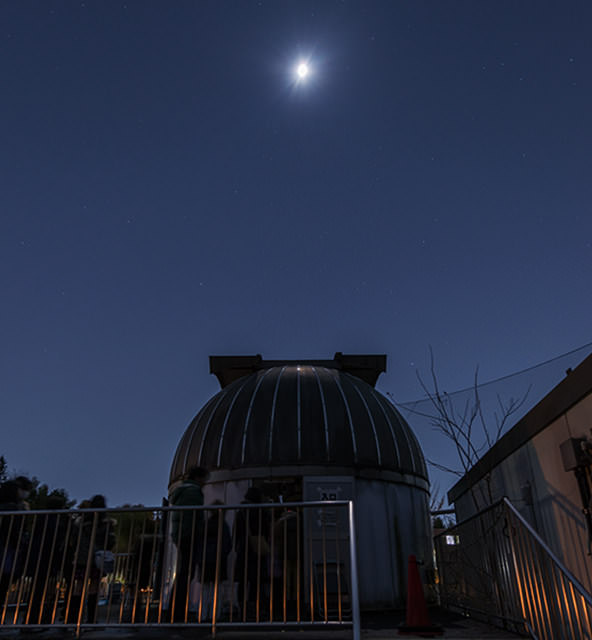
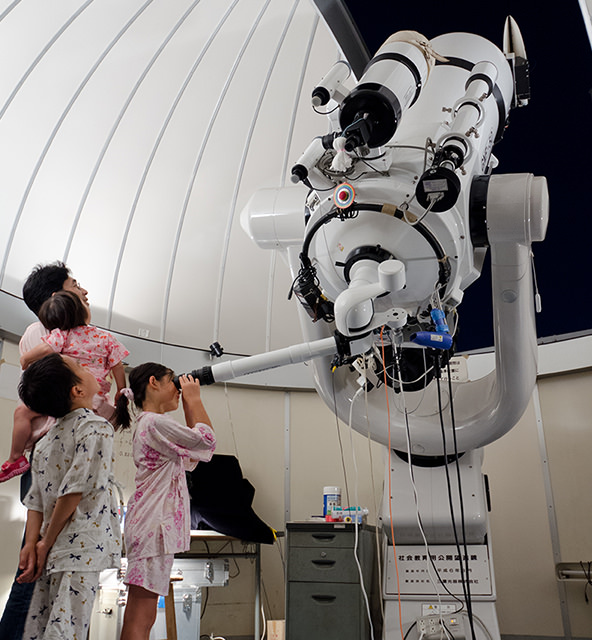
Regular Stargazing Parties are held at NAOJ Mitaka Campus (limited capacity, reservations required). In cities, street lamps conceal the dark night sky. But that doesn’t change the fact that even now the Universe stretches out over our heads. We want many people to experience the splendor and wonder of the Universe and embrace an interest in astronomy at these Regular Stargazing Parties.
Some of the event staff can speak English, but the Regular Stargazing Parties are conducted primarily in Japanese. We appreciate your understanding and cooperation.
Objects Observed

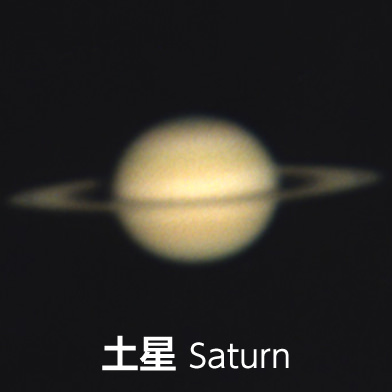

The chosen observation targets are concentrated around the Moon, planets, and double stars which are easy to observe in Tokyo’s bright night sky. With the 50-cm Telescope for Public Outreach, the impressive craters on the Moon, Jupiter’s striped pattern and the Galilean Satellites, Saturn’s Ring, etc. can be seen clearly. The colors of bright stars can also be easily discerned; second magnitude stars appear very beautiful.
Sometimes the observation targets also include faint objects like nebulae and star clusters. We choose relatively easy to observe celestial objects, but in truth they look paler than what is seen in photos.
Order of Events at the Regular Star Parties (2025)
Belongings
- Transmission of lottery results (email screen or printout)
- (winter season) Cold Weather Wear/Gear, (summer season) Heatstroke Measures, Insect Repellent etc.
Precautions
- Admission may be refused if you are experiencing a fever. Please check your physical condition.
- Even in the case of rain or cloud, the event takes place, with a lecture and a tour of the 50cm Public Telescope. (When the event could be cancelled in the case of a typhoon or heavy snow, it would be announced beforehand.)
- If we have concerns on the weather condition of the event day, we will remark on X (former Twitter) @naoj_kanboukai (best-effort).
- Things emitting light that will obscure stargazing such as light-up shoes for kids are prohibited to bring in.
- Please be aware of no food in the venue except the water supply.
- The closing time of toll parking is extended only to the day of the stargazing event. Please enter the back gate of Mitaka Campus. You cannot pass through the campus if you enter the main gate.
- Smoking is prohibited both indoors and outdoors.
- Please follow directions by staff on the use of flashlights, cameras, and mobile devices
1. Reception
Reception is in the lobby of the low-rise building (the Central Building) you see in front after entering the Main Gate.
The venue opens 10 minutes prior to reception time. You cannot enter before that time.
Please keep in mind to arrive just in your reception time. You are guided in the same appointed group regardless of how early you have arrived.
- We will check your lottery result at the reception. Please show the transmission mail screen or printout.
- After reception, we will direct you to the lecture room.
2. Explanation
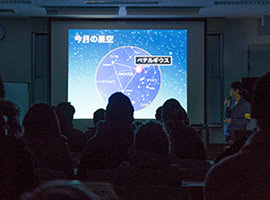
In a lecture room, a simple explanation of observational targets is presented. (In Japanese. Usually about 15 minutes, in the case of bad weather a little longer.)
The explanation is given by undergraduate or graduate students conducting research in astronomy. They work hard to come up with new material for each time. Please enjoy it.
When it rains (you cannot visit the telescope), the video of scheduled objects recorded beforehand will be screened.
3. Move to Stargazing Site
After an explanation, we will move to the stargazing site outdoor (in the case of a clear or cloudy weather).
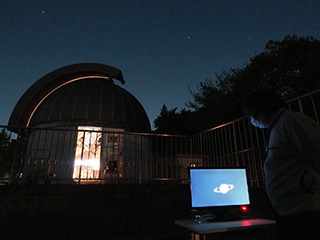
On a Clear Day (Electrically Assisted Astronomy)
- Attendees observe realtime celestial images delivered on monitors from cameras installed on telescopes with all group members at once with an explanation (you will not look through the telescope directly).
- We will show multiple objects in addition to the main target (depending on the sky conditions).
- Photo shoot of images on monitors is permitted.
- You can leave midway.
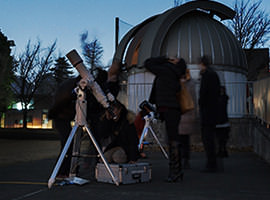
On a Clear Day (Direct Viewing)
- Attendees observe objects looking through the 50cm Public Telescope directly one by one in turn. (In principle, we will show two objects, depending on the weather condition.)
- It takes a certain time for all attendees to have finished observing, and it happens that the stargazing is interrupted midway when the sky condition has got worse.
- Observation with small telescopes on the ground will be also supplied.
- Photo shoot is prohibited during the observation (use of light-emitting objects that disturbs the observation is generally prohibited.)
- If you have concern about the infection through mucus membrane around eyes, please wear glasses for self-protection when you observe with telescopes.
- You can leave midway.
On a Cloudy Day
- Attendees watch videos of target objects recorded with 50cm Public Telescope beforehand on monitors.
- Facility tour of 50cm Public Telescope is available.
- Photo shoot of both images on monitors and the telescope is permitted.
- Please feel free to break up after the tour.
On a Rainy Day
- Videos of target objects recorded with 50cm Public Telescope beforehand are screened following the explanation. Break up without moving outdoors. (Facility tour of 50cm Public Telescope is not served.)
Thank you for your attendance. We hope you have a safe trip back home.
In the case of rain or bad weather, astronomical observations can’t be conducted.
The explanation will be extended by about 15-20 minutes.
Instead of astronomical observations, commentary using the Four Dimensional Digital Universe visualization software Mitaka or a tour of the 50-cm Telescope for Public Outreach will be offered (both minimal English). (Telescope tours aren’t possible when it is raining.)
Whether astronomical observations will be conducted or canceled will be announced that day via Twitter (Japanese language only.) Please check this on the day of the Regular Stargazing Party.
About the 50-cm Telescope for Public Outreach
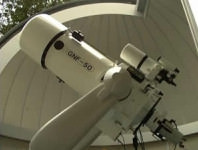
The 50-cm Telescope for Public Outreach was established in 1994, with public access as one of the primary motivations. Regular Stargazing Parties with this telescope started in 1996. Since then, many people have experienced the wonder of astronomical observations. In addition to Regular Stargazing Parties, the telescope is used for activities like comet research observations, capturing images for public outreach, and student practice observations.
| Configuration | Cassegrain Reflecting Telescope |
|---|---|
| Mount | Equatorial Fork |
| Aperture (Primary Mirror Diameter) | 50 centimeters |
| Focal Length | 6030 millimeters |
| Resolving power | 0.3 arcseconds (theoretical limit) |
| Light Gathering Power | About 5000 times that of the naked eye |
| Limiting Magnitude for Observing by Eye | 16th Magnitude (ideal sky conditions) |
| Limiting Magnitude with the Cooled CCD | 21st Magnitude (in Mitaka with ideal sky conditions) |
